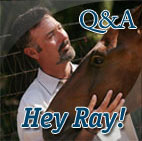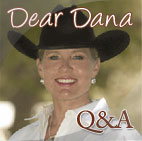Right and Left-Hoofed Horses

32nd in a series
After familiarizing us with shoulder control exercises last issue, Les teaches us to refine the drills with some specific tips.
We’re going to be asking the horse to yield and bend to either side in a willing, balanced manner in response to pressure from a single rein.
More shoulder control exercises

31st in a series
Last issue, Les defined simple steps with the shoulder that will open the door for many maneuvers in the future. Here’s a wrap-up before moving on.
Shoulder Control Exercise #2

30th in a series
Last issue, Les outlined in detail the art of overcoming resistance. Now we’ll open more doors by learning to control the shoulders.
Up until this point we’ve primarily focused on influencing the horse’s head and neck through lateral and vertical flexion. In this lesson you’re going to move back a zone and learn to control the shoulders. Once you can do that it opens the door for many of the maneuvers that you’ll be working on in the future.
The art of overcoming resistance

29th in a series
Last issue, Les wrapped up vertical flexion with details of maintaining softness in the neck. This puts us at a great point to address the art of overcoming your horse’s resistance.
Many times, as you’re working through this program, the resistance you feel may actually be confusion on the part of your horse. They aren’t brain surgeons, remember. There will always be a period of discomfort, and a little confusion as you introduce new things, but if you are consistent with your demands and rewards they will soon figure out how to please you. Horses are creatures of habit and conditioning; the more consistent you are, the more quickly they will give you the results you want.
Maintaining Softness in the Neck

29th in a series
Last issue, Les drilled down in detail lessons on achieving vertical flexion. Softness in the neck is key. Here’s a look.
Again, the first place that resistance is going to show up is in your horse’s neck. You’re going to ask him to do something, and rather than softly responding he’s going to stiffen his neck and brace against your hand. You simply have got to train yourself to not let this happen. You have to insist that he be soft in the poll at all times.
Adding Vertical Flexion to Bend
 28th in a series
28th in a series
As Les continues his lessons on vertical flexion this issue, we see the steps in sharper detail.
Since in last lesson’s exercises we asked you to be conscious of the horse’s nose getting too far out in a turn, this exercise shouldn’t be new to you. But before, you only used the outside rein to correct problems; here I want you to use the outside rein consciously, as you ask the horse to really break at the poll and bring his nose toward his chest from the lateral flexion position.
Vertical Flexion: Train for ‘feel’
 27th in a series
27th in a series
Last issue, Les reviewed the critical role of timing in the release. Now we pick up with vertical flexion, first at a standstill, then on a straight line.
Your first attempt at vertical flexion can be done at the standstill. In the video component of the program you’ll see me working with riders at a clinic to get their horses to drop their noses in response to my hand and leg collection aids. Once you’ve watched it, go try it with your horse.
The Release: Timing is everything
26th in a series
Last issue, Les explained how a horse is “soft in the bridle” when he has achieved vertical flexion. This issue, we pick up with an important component: the thought — the gesture — that he is willing to think about giving his nose to the pressure on the rein.
How can you make it easier for him to learn this lesson? Timing. To me, timing means release. If someone says a person has really good timing, it could mean they rode well, and their timing in terms of when to pick up a horse was good; but most important is the timing of release, because that’s the horse’s reward. You might still be kind of awkward with your riding, but if you create even an accidental thought or movement, make sure you take credit for it and reward your horse.
Soft in the bridle: Vertical Flexion
 26th in a series
26th in a series
Last issue, Les explained the components of vertical flexion. Now we’ll take a deeper look.
We say a horse is “soft in the bridle” when he has achieved soft vertical flexion – that is, when the horse will drop his nose by rounding his neck and poll whenever he feels light contact with both reins. Your ultimate goal is to get this reaction from your horse before you’ve even taken all the slack out of your reins – like you could ride with silk threads and not break them – wouldn’t that be great! We all dream about it!
Vertical Flexion
 25th in a series
25th in a series
Last issue, Les reinforced communication with pattern exercises; now we’ll move to the key of a supple neck.
Objective: To begin to get your horse to give at the poll as a result of soft pressure on his mouth with both reins.
Skills You Will Develop
Timing – Timing is critical in this stage of the program. You want to make sure that you reward your horse instantly when you get the result you want so he learns to give and not pull.



 Read Columns
Read Columns

